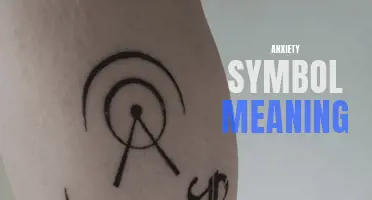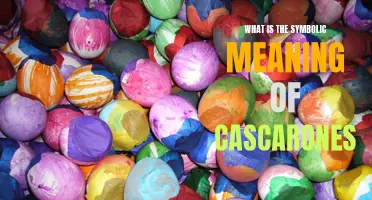
Symbols have long been used to convey profound meanings and ideas, and one of the most powerful concepts that has been represented through various symbols is change. From ancient times to modern society, symbols that mean change have served as a way to capture the essence and significance of transformations, both personal and societal. Whether it's the butterfly emerging from its cocoon or the phoenix rising from the ashes, these symbols not only encapsulate the idea of change but also provide us with hope, inspiration, and a reminder that transformation is an inevitable and necessary part of life. In this article, we will explore some of the most intriguing symbols that signify change, delving into their rich histories and exploring the deep significance they hold in different cultures around the world.
What You'll Learn
- What are some common symbols that represent change in different cultures?
- How have symbols representing change evolved over time?
- Are there any symbols that are universally recognized as representing change?
- What meanings or interpretations are associated with specific symbols that represent change?
- How do symbols representing change influence and shape societal and individual perception of change?

What are some common symbols that represent change in different cultures?
Symbols are a powerful form of communication that can convey complex ideas and concepts. One such concept that is often represented by symbols is change. Across different cultures, there are numerous symbols that are commonly associated with change. Let's explore some of these symbols and their meanings.
In the Chinese culture, one of the most well-known symbols of change is the yin and yang symbol. This symbol represents the balance between opposing forces, such as light and dark, hot and cold, and good and evil. It signifies that change is a natural and necessary part of life, and that there is always a balance between opposing forces.
In Hinduism, the lotus flower is a symbol of change. The lotus begins its life in muddy waters, but eventually rises above the surface and blooms into a beautiful flower. This transformation represents the journey of the soul, and symbolizes the process of spiritual awakening and growth.
In Native American culture, the butterfly is often seen as a symbol of change. The transformation of a caterpillar into a butterfly represents the process of personal growth and transformation. It reminds us that change is a necessary and beautiful part of life, and encourages us to embrace it.
In Celtic culture, the triskelion is a symbol of continuous change and evolution. This symbol features three interlocking spirals that represent the cycles of life, death, and rebirth. It symbolizes the idea that change is a natural part of the human experience, and that we are constantly evolving and growing.
In Buddhism, the wheel of Dharma is a symbol of change and spiritual transformation. The wheel represents the teachings of Buddha and the path to enlightenment. It reminds us that change is a constant and inevitable part of life, and that embracing change is essential for spiritual growth.
In African culture, the Ankh symbol is often associated with change and transformation. The Ankh is a cross with a loop at the top, and represents the key of life. It symbolizes the concept of eternal life and the cycle of birth, death, and rebirth. It reminds us that change is a necessary and integral part of the human experience.
These are just a few examples of the many symbols that represent change in different cultures. Whether it's the yin and yang symbol in Chinese culture or the lotus flower in Hinduism, these symbols serve as powerful reminders that change is a natural and necessary part of life. They encourage us to embrace change, embrace growth, and embrace the transformative power it can bring. So the next time you encounter a symbol of change, remember its significance and the wisdom it holds.
Decoding the Mystical Symbols of Destiny 2: Unraveling Their Hidden Meanings
You may want to see also

How have symbols representing change evolved over time?
Symbols representing change have evolved over time in conjunction with the human understanding and perception of change itself. These symbols serve as a visual representation of a concept that can often be abstract and intangible. By encapsulating the idea of change with a simple visual image, symbols provide a means for communication and understanding across cultures and languages.
Throughout history, numerous symbols have emerged to represent the concept of change. One of the oldest and most iconic symbols of change is the Greek letter delta (∆). The delta has been used since ancient times to represent change in mathematics and science, where it is often used to denote a difference or a change in a certain variable. Its triangular shape, with one corner pointing upwards, visually represents a shift or transformation.
In addition to the delta symbol, various other symbols have also emerged to represent different aspects of change. The yin and yang symbol from Chinese philosophy, for example, represents the perpetual duality and balance of change. The black and white halves of the symbol signify the ever-changing nature of life and the interplay between opposing forces. The symbol not only represents change but also highlights the need for harmony and equilibrium.
Another symbol that has come to represent change is the butterfly. The butterfly undergoes a transformative process called metamorphosis, where it changes from a caterpillar to a beautiful winged creature. This process has long been associated with personal and spiritual transformation, making the butterfly a powerful symbol of change.
In recent years, with the advent of technology and the digital age, new symbols have emerged to represent change. The most recognizable of these symbols is the circular arrow, commonly known as the refresh symbol. This symbol is often seen on web browsers and software applications to indicate a change or update in content. The circular shape of the arrow represents the cyclical and continuous nature of change, reminding users that change is a constant part of life.
As society progresses, symbols representing change will undoubtedly continue to evolve. With the constant development of new ideas and the acceleration of technological advancements, new symbols will emerge to capture the nuances and complexities of the changing world. These symbols will serve as visual cues that facilitate communication and understanding, allowing individuals to navigate and adapt to the ever-changing landscape of life.
In conclusion, symbols representing change have evolved over time to reflect humanity's understanding and perception of change. From ancient symbols like the delta and the yin and yang to more modern symbols like the butterfly and the refresh icon, these symbols encapsulate the concept of change in a visual form. As society evolves, new symbols will continue to emerge, further enriching our understanding of the dynamic and ever-changing world we live in.
Understanding Buddhist Symbols and Their Meanings
You may want to see also

Are there any symbols that are universally recognized as representing change?
Symbols have been used throughout history to represent various concepts and ideas. When it comes to change, there are several symbols that are commonly recognized and associated with this concept across different cultures and societies.
One symbol that is universally recognized as representing change is the butterfly. The transformation of a caterpillar into a butterfly is often seen as a metaphor for personal growth and change. The butterfly symbolizes the process of metamorphosis, where something undergoes a remarkable transformation. It represents the idea that change can bring beauty and freedom.
Another symbol that is widely recognized as representing change is the hourglass. The hourglass is often used to represent the passing of time and the inevitability of change. The sand in the hourglass gradually falls from the top chamber to the bottom, symbolizing the constant flow of time and the need to adapt to change. It serves as a reminder that change is a natural part of life and should be embraced.
The yin and yang symbol is another symbol that can be associated with change. This symbol represents the concept of balance and harmony. The yin, which is the dark swirl, represents the feminine, passive, and receptive energy, while the yang, the light swirl, represents the masculine, active, and assertive energy. The symbol as a whole represents the idea that change is a constant and ever-shifting balance between opposing forces. It emphasizes the need for adaptability and finding harmony in a world of change.
The phoenix is also a widely recognized symbol of change. In many mythologies and cultures, the phoenix is portrayed as a bird that rises from its own ashes. This symbolizes the idea of rebirth and renewal, where something old must be destroyed or let go in order for something new to emerge. The phoenix represents a powerful transformation and serves as a reminder that change often comes after a period of destruction or loss.
In conclusion, there are several symbols that are universally recognized as representing change. The butterfly, hourglass, yin and yang, and phoenix are all widely associated with the concept of change and serve as powerful reminders of its inevitability and transformative nature. Whether it is personal growth, the passage of time, finding balance, or the process of rebirth, these symbols help us understand and embrace the idea that change is a constant and necessary part of life.
The Symbolic Meaning of Bird Poop on Your Car: What Does it Signify?
You may want to see also

What meanings or interpretations are associated with specific symbols that represent change?
Symbols have always played a significant role in human culture and communication. They have the power to convey deep meanings and provoke thought and contemplation. When it comes to representing change, there are several symbols that have come to be associated with this concept. Let's explore some of the meanings and interpretations behind these symbols.
The first symbol often associated with change is the butterfly. The caterpillar's transformation into a beautiful butterfly is a classic representation of change and metamorphosis. The butterfly symbolizes personal growth, renewal, and transformation. It is a reminder that change, although sometimes difficult and uncomfortable, can lead to a more beautiful and fulfilling life.
Another symbol closely associated with change is the phoenix. In mythology, the phoenix is a creature that is consumed by fire and reborn from its own ashes. It embodies the idea of resurrection and rising from the ashes stronger and more powerful. The phoenix symbolizes the ability to overcome adversity and start anew.
The yin and yang symbol from Taoism also has a connection to change. This symbol represents the idea of balance and harmony in the universe. It suggests that change is an inherent part of life and that opposing forces are necessary for growth and transformation. The dark and light sides of the yin and yang symbolize the ever-shifting nature of existence.
The hourglass is another symbol that represents change. It symbolizes the passing of time and the inevitability of change. The sand slipping through the hourglass serves as a reminder that change is constant and relentless. It urges us to embrace change and make the most of the time we have.
The Celtic knot is a symbol that can also be associated with change. Its intricate, looping design has no beginning or end, symbolizing the infinite cycle of life and the interconnectedness of all things. The Celtic knot reminds us that change is a natural part of this cyclical process and that every ending is also a new beginning.
In conclusion, symbols have the power to represent complex ideas and emotions. When it comes to representing change, symbols like the butterfly, phoenix, yin and yang, hourglass, and Celtic knot have all been used to convey the multifaceted nature of change. These symbols remind us that change is an essential part of life and can lead to personal growth and transformation. They urge us to embrace change and view it as an opportunity for renewal and a fresh start.
The Fascinating Meanings Behind Symbols on Shoes
You may want to see also

How do symbols representing change influence and shape societal and individual perception of change?
Symbols have always played a significant role in shaping societal and individual perception of change. They act as powerful visual representations that can evoke emotions, convey messages, and influence the way we think about and understand change.
Symbols representing change can take many forms, such as arrows, scales, hourglasses, and butterflies. These symbols are often used in various contexts, including advertising, art, and literature, to illustrate the concept of change and its potential impacts.
One way symbols representing change influence societal perception is by creating a visual language that everyone can understand, transcending cultural and linguistic barriers. For example, the universal symbol for recycling, the three arrows looping into one another, communicates the importance of environmental change and encourages individuals to take action. This symbol has become so ingrained in our collective consciousness that it instantly conveys the concept of change and the need for sustainability.
Symbols also have the power to shape individual perception of change. When we see a symbol representing change, our brains automatically make connections and associations based on our previous experiences and knowledge. For instance, an arrow pointing upwards represents positive change or progress, while a downward arrow signifies negative change or regression. These associations can influence how we interpret and react to change in our personal lives.
Moreover, symbols representing change often carry cultural and historical meanings that further shape our perception. For example, the scales of justice symbolize the need for fairness and equity, and their use in legal systems communicates the idea that change can bring about justice. On the other hand, the hourglass symbolizes the passage of time and the inevitability of change, reminding us of the transience and impermanence of life.
Symbols can also be used strategically to drive specific narratives or agendas surrounding change. For instance, political campaigns often use symbols such as the handshake or the rising sun to convey messages of hope, unity, and progress. These symbols create a sense of optimism and inspire individuals to embrace change.
In conclusion, symbols representing change play a crucial role in shaping societal and individual perception of change. They offer a visual language that transcends cultural and linguistic barriers, evoke emotional responses, and create associations based on our previous experiences and knowledge. By understanding the power of these symbols, we can better navigate and make sense of the complex and ever-changing world around us.
Understanding the Hyundai Palisade Dashboard Symbols and Meanings
You may want to see also
Frequently asked questions
One common symbol for change is the Greek letter delta (Δ). It is often used in mathematics and science to represent a change or difference.
Yes, there are many symbols that can represent change. For example, the yin and yang symbol from Chinese philosophy is often associated with the idea of balance and change. The butterfly is also a symbol of transformation and change due to its natural life cycle.
The arrow symbol for change can represent moving forward, progress, or direction. It can symbolize leaving the past behind and embracing new beginnings. Arrows are often used in signage and logos to indicate change and movement.
Yes, the lotus flower is often seen as a symbol of positive change. In many Eastern cultures, the lotus flower represents purity, enlightenment, and transformation. It is often used to symbolize personal growth and spiritual development.







